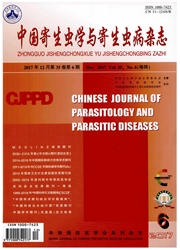

 中文摘要:
中文摘要:
目的 应用空间流行病学方法分析血吸虫病疫情特征,探索回顾性时空重排扫描统计量在湖沼型、山丘型血吸虫病流行区聚集性探测研究中的应用。 方法 分别收集2009-2014年江西省和2004-2013年云南省的血吸虫感染人群、耕牛和钉螺的疫情资料,进行描述性流行病学分析,并应用回顾性时空重排扫描统计量方法,对江西省和云南省血吸虫病高风险传播区域的时空分布进行空间聚集性分析。 结果 2009-2014年江西省人群、耕牛和钉螺的血吸虫感染率均呈逐年下降的趋势,人群和钉螺感染率分别由2009年的0.21%和0.03%下降至2014年的0.01%和0,耕牛感染率从2012年的1.25%下降至2014年的0.12%,其中人群感染率年平均变化百分比(APC)为-47.36%(P 〈 0.05);2009-2014年人群、耕牛和钉螺感染率均存在时空分布聚集性,分别探测出3、2和1个聚集区域,均位于环鄱阳湖地区。2004-2013年云南省人群、钉螺和耕牛血吸虫感染率呈逐年下降的趋势,2004年感染率分别为2.49%、0.70%和3.76%,至2013年,人群和钉螺感染率均为0,耕牛感染率下降为0.02%;其中人群感染率APC为-49.17%(P 〈 0.05);2004-2013年人群、钉螺和耕牛感染率均存在时空分布聚集性,分别探测出2、6和2个聚集区域。结论 2009-2014年江西省湖沼型和2004-2013年云南省山丘型流行区血吸虫病疫情均呈现下降趋势,回顾性时空重排扫描统计量分析均发现有人群、钉螺和耕牛感染率的聚集性区域,表明可用于分析血吸虫病时空分布特征。
 英文摘要:
英文摘要:
Objective To analyze the characteristics of schistosomasis prevalence by using the spatial epidemiological method, and test the application of retrospective space-time permutation scan statistics in determining mountainous and lake-type endemic areas of schistosomiasis. Methods The data of schistosomasis in humans, cattle and snails in Jiangxi Province during 2009-2014 and in Yunnan Province during 2004-2013 were collected and analyzed. The temporal and spatial distribution of schistosomiasis endemic areas in the two provinces was analyzed with retrospective space-time permutation scan statistics. Results The prevalence of schistosomiasis in residents and Oncomelania snails showed a trend of decline in Jiangxi, from 0.21% and 0.03% in 2009 to 0.01% and zero in 2014. A similar trend was found in cattle, from 1.25% in 2012 to 0.12% in 2014. The average annual percentage change (APC) in residents was-47.36%(P 〈 0.05). The space-time permutation clustering analysis revealed a temporal and spatial clustering of schistosomiasis prevalence from 2009 to 2014 in residents, cattle, and snails, with 3,2 and 1 clustering areas, respectively, all distributed in Poyang Lake Region. A similar declining trend of schistosomiasis prevalence was found in residents, snails and cattle in Yunnan during 2004-2013, from 2.49%,0.70% and 3.76% in 2004 to no infection in residents and snails and 0.02% in cattle in 2013. The APC in residents was-49.17%(P 〈 0.05). There was a temporal and spatial clustering of schistosomiasis prevalence during 2004-2013 in residents, cattle, and snails, with 2,2 and 6 clustering areas, respectively. Conclusion A declining trend of schistosomiasis prevalence is shown in lake-type endemic areas in Jiangxi during 2009-2014 and in mountainous endemic areas in Yunnan during 2004-2013. The retrospective space-time permutation scan statistics reveal a clustering of schistosomiasis in humans, cattle, and snails, suggesting its applicability in analyzing the temporal and spatial distribution of schist
 同期刊论文项目
同期刊论文项目
 同项目期刊论文
同项目期刊论文
 Successful outcome of an integrated strategy for the reduction of schistosomiasis transmission in an
Successful outcome of an integrated strategy for the reduction of schistosomiasis transmission in an Isolation and Characterization of 15 New Microsatellite Markers in Oncomelania hupensis, the Snail I
Isolation and Characterization of 15 New Microsatellite Markers in Oncomelania hupensis, the Snail I Exploring the Potential Transmission Risk of Schistosomiasis Japonica in the Lower Reaches of the Ya
Exploring the Potential Transmission Risk of Schistosomiasis Japonica in the Lower Reaches of the Ya Potential schistosomiasis foci in China: A prospective study for schistosomiasis surveillance and re
Potential schistosomiasis foci in China: A prospective study for schistosomiasis surveillance and re Fine Scale Spatial-temporal Cluster Analysis for the Infection Risk of Schistosomiasis Japonica Usin
Fine Scale Spatial-temporal Cluster Analysis for the Infection Risk of Schistosomiasis Japonica Usin 期刊信息
期刊信息
